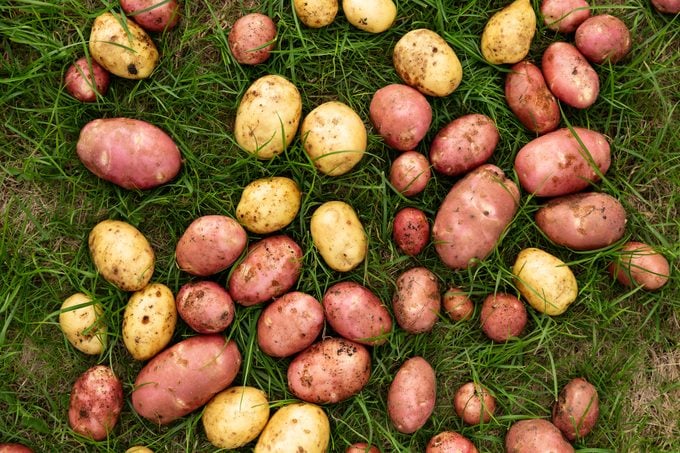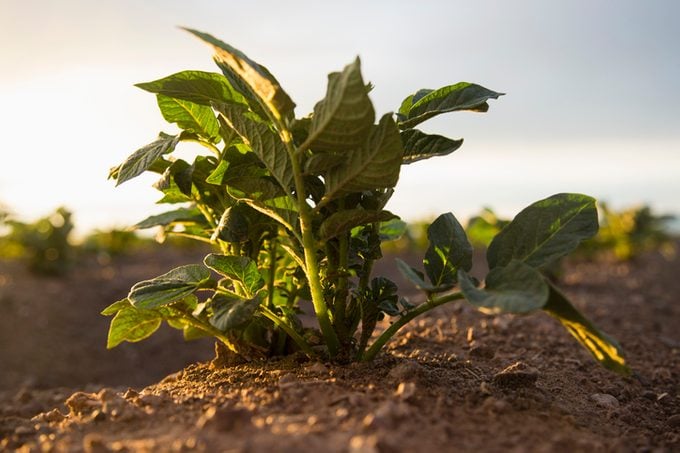How to Grow Potatoes in a Vegetable Garden
Updated: Jun. 07, 2024
If you love eating potatoes, you might be curious about how to grow potatoes in your garden. Learn the best tips for a successful harvest.

Potatoes are a productive and delicious crop to plant in a home garden. According to Doug Oster, a Pittsburgh based garden expert, author, and radio host, “Potatoes are very easy to grow and there’s nothing like fresh potatoes out of the garden at harvest time.” Plus, there’s a wide range of tuber colors, shapes, and sizes available from garden centers, farm supply stores, and seed catalogs. Something for everyone! Here’s everything you need to know about how to grow potatoes.
On This Page
Start by Buying Seed Potatoes
Potatoes are grouped into one of three categories: early season (70 to 90 days), mid-season (90 to 110 days), and late season (110 to 130 days). The first step in growing a bumper crop of homegrown spuds is to buy seed potatoes. Note that these are not seeds, but rather a potato (tuber) used to start potato plants in the garden.
Doug recommends using certified seed potatoes, not potatoes from the grocery store. “Certified potatoes are checked to ensure they are disease-free,” he says.
Should you grow hybrid or heirloom tomatoes?
Do You Need to Pre-sprout Seed Potatoes?

Get a head start on the growing season by chitting the seed potatoes about a month before you intend to plant them outdoors. Chitting introduces the tubers to light which breaks their dormancy and encourages stocky sprouts to grow. Pre-sprouting seed potatoes isn’t necessary but it can speed up plant emergence.
Chit seed potatoes by placing them in open egg cartons or on trays in a bright but cool spot. It may take a few weeks, but sprouts will emerge from the eyes. When those sprouts are about an inch long, the seed potatoes are ready to plant.
Check out our ultimate guide to growing zucchini.
Prepping Seed Potatoes
There are two ways to plant seed potatoes: in pieces or whole. “If the seed potato is golf ball sized, I’ll plant it whole,” says Doug.
Larger tubers are cut into pieces to get more plants. Using a sharp clean knife carefully slice each seed potato into chunks about the size of an egg. Each segment should have two eyes, or sprouts. “Leave the cut seed potatoes out to heal over and dry for two days, says Doug. “This helps prevent rot.”
How to Plant Seed Potatoes

Like most vegetables potatoes grow best in a sunny garden bed with fertile, loose soil. Plant as early as two to four weeks before the last expected spring frost date. “Some gardeners get their seed potatoes in the ground a month before the last frost, but I prefer to plant when the soil is warmer, about two weeks in advance of the predicted last frost,” says Doug.
When the time is right, Doug prefers to dig a trench 8 to 12 inches deep, adding several inches of compost to the bottom. “Sprinkle in a balanced, organic fertilizer and place the seed potatoes, with the eyes up, into the trench.”
Some gardeners plant in properly prepared soil 3 to 5 inches deep and then hill as the potaotes grow, adding soil several times.
Space the tubers 12 inches apart and leave 18 to 24 inches between each row.
Potato Plant Care and Growing Tips

When the plants are 8 inches tall, Doug recommends hilling them by hoeing several inches of soil or compost around the stems. Hilling potato plants keeps the tubers well buried and away from sunlight. If the tubers develop on the soil surface they’ll turn green and become bitter. “It also increases yield, continues to warm up the soil, and improves drainage,” says Doug.
Encourage healthy plant growth and good tuber development by providing a consistent supply of water. Potatoes should usually (depends on soil and temperatures, as well) be deep watered weekly if there has been no rain. Too little rain can reduce tuber size and prompt them to develop hollow heart.
Potato Plant Problems and Troubleshooting

Like their tomato cousins potato plants are prone to a range of pests and diseases. “One of the most common pests is the Colorado potato beetle,” says Doug. “Both the larvae and adults are voracious and can eventually kill a plant.” To reduce the population, he suggests looking for clusters of the yellowish-orange eggs on the bottoms of the leaves. “Crush them whenever they are found.”
For the adult Colorado potato beetles, Doug suggestions spraying the foliage with an organic control like spinosad. “When ingested by the pest, the active ingredient affects the nervous system,” he says. “The beetles stop feeding and then die.” As always read and follow label directions. For small infestations you can hand pick the beetles as a control. Some gardeners even use a hand vac.
Potatoes are also prone to diseases like early blight, late blight, fusarium dry rot, and potato scab. “Pairing certified seed potatoes with crop rotation and fertile, well-drained soil goes a long way to harvesting healthy potatoes,” says Doug.
Here’s how to keep squash bugs out of your garden.
How to Grow Potatoes in Containers

If you’re short on garden space you can plant seed potatoes in pots. “I plant them in 15 gallon fabric pots,” says Doug. “Fill the container halfway with potting mix and place the seed potatoes on the soil.” Cover them with a couple inches of potting mix.
When the plants are 10 inches tall he adds more potting mix to ‘hill’ the potatoes. “At the end of the season turn the bag over for a wonderful harvest,” he says.
Learn how to grow blueberries in your own backyard.
When to Harvest Potatoes

Early season potatoes are often dug as new or baby potatoes, while mid-season and late varieties are harvested as a main crop when the plants die back in autumn.
“One of the best parts of growing your own potatoes is harvesting tender new potatoes,” says Doug. “Carefully dig for new potatoes a couple of weeks after the plants flower.” He suggests pulling a few young potatoes from each plant and letting the rest of the tubers develop for future harvests.
For main crop or storage potatoes, harvest when the stems and leaves die back in late summer or early autumn. Dig carefully to avoid damaging the tubers. Let the potatoes sun cure on the soil surface for a few hours and then store them in a cool, dark location with good air circulation.
Best Potato Varieties to Grow

When it comes to picking which varieties to grow, Doug says don’t be shy about trying new-to-you potatoes. “Some of the more popular varieties include Kennebec, Yukon Gold and Red Norland, but I also love fingerling varieties which are small and packed with flavor,” he says.
Here are some of the best potato varieties to try:
- Early season – Red Norland, Caribe, Irish Cobbler, Yukon Gold
- Mid-season – Purple Majesty, Yukon Gem, Kennebec
- Late season – French Fingerling, German Butterball, Russet Burbank
Next, learn how to grow strawberries.
About the Expert
Doug Oster is a Pittsburgh based garden expert, radio and TV host, author of five books, and homegrown potato lover. He’s also an Emmy-award winning writer and producer for the documentary Gardens of Pennsylvania.
Sources
- University of Minnesota Extension
- Michigan State University – A Guide to Growing Potatoes in Your Home Garden
- Cornell University – Potatoes Growing Guide
- University of Connecticut – Spinosad: The First Selective, Broad-Spectrum Insecticide





















